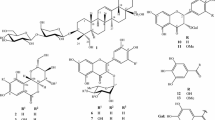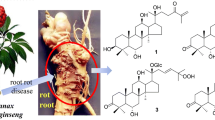Abstract
Five compounds were isolated from the chloroform-soluble fraction of the methanolic extract of the dried rhizomes of Zingiber officinale (Zingiberaceae) through repeated column chromatography. Their chemical structures were elucidated as 4-, 6-, 8-, and 10-gingerols, and 6-shogaol using spectroscopic analysis. Among the five isolated compounds, 6-shogaol exhibited the most potent cytotoxicity against human A549, SK-OV-3, SK-MEL-2, and HCT15 tumor cells. 6-shogaol inhibited proliferation of the transgenic mouse ovarian cancer cell lines, C1 (genotype: p53-/-, c-myc, K-ras) and C2 (genotype: p53-/-, c-myc, Akt), with ED50 values of 0.58 μM (C1) and 10.7 μM (C2).
Similar content being viewed by others
References
But, P. P. H., Kimura, T., Guo, J.-X., and Sung, C. K., International collation of traditional and folk medicine. World Scientific, Singapore, p. 400, (1997).
Denniff, P., Macleod, I., and Whiting, A. A., Studies in the biosynthesis of [6]-gingerol, pungent principle of ginger (Zingiber officinale). J. C. S. Perkin I, 2637–2644 (1980).
Hori, Y., Miura, T., Hirai, Y., Fukumura, M., Nemoto, Y., Toriizuka, K., and Ida, Y., Pharmacognostic studies on ginger and related drugs-part 1: five sulfonated compounds from Zingiberis rhizome (Shokyo). Phytochemistry 62, 613–617 (2003).
Jang, I. M., Treatise on Asian herbal medicines. Daewon, Seoul, pp. 1030–1031, (2003).
Jolad, S. D. R., Lantz, C., Chen, G. J., Bates, R. B., and Timmermann, B. N., Commercially processed dry ginger (Zingiber officinale): Composition and effects on LPS-stimulated PGE2 production. Phytochemistry 66, 1614–1635 (2005).
Lee, E. and Surh, Y.-J., Induction of apoptosis in HL-60 cells by pungent vanilloids, [6]-6gingerol and [6]-paradol. Cancer Lett. 134, 163–168 (1998).
Ma, J., Jin, X., Yang, L., and Liu, Z.-L., Diarylheptanoids from the rhizomes of Zingiber officianle. Phytochemistry 65, 1137–1143 (2004).
Masuda, Y., Kikuzaki, H., Hisamoto, M., and Nakatani, N., Antioxidant properties of gingerol related compounds from ginger. BioFactors 21, 293–296 (2004).
Miyoshi, N., Nakamura, Y., Ueda, Y., Abe, M., Ozawa, Y., Uchida, K., and Osawa, T., Dietary ginger constituents, galanals A and B, are potent apoptosis inducers in Human T lymphoma Jurkat cells. Cancer Lett. 199, 113–119 (2003).
Orsulic, S., Li, Y., Soslow, R. A., Vitale-Cross, L. A., Gutkind, J. S., and Varmus, H. E., Induction of ovarian cancer by defined multiple genetic changes in a mouse model system. Cancer Cell. 1, 53–62 (2002).
Ryu, S. Y., Choi, S. U., Lee, C. O., and Zee, O. P., Antitumor activity of Psoralea corylifolia. Arch. Pharm. Res., 15, 356–359 (1992).
Shoji, N., Iwasa, A., Takemoto, T., Ishida, Y., and Ohizumi, Y., Cardiotonic principles of ginger (Zingiber officinale Roscoe). J. Pharm. Sci. 71, 1174–1175 (1982).
Skehan, P., Storeng, R., Scudiero, D., Monks, A., McMahon, J., Vistica, D., Warren, J. T., Bokesch, H., Kenney, S., and Boyd, M. R., New colorimetric cytotoxicity assay for anticancer-drug screening. J. Natl. Cancer Inst., 82, 1107–1112 (1990).
Wei, Q.-Y., Ma, J.-P., Cai, Y.-J., Yang, L., and Liu, Z.-L., Cytotoxic and apoptotic activities of diarylheptanoids and gingerol-related compounds from the rhizome of Chinese ginger. J. Ethnopharmacol., 102, 177–184 (2005).
Xing, D. and Orsulic, S., A genetically defined mouse ovarian carcinoma model for the molecular characterization of pathway-targeted therapy and tumor resistance. P. N. A. S., 102, 6936–6941 (2005).
Author information
Authors and Affiliations
Corresponding author
Rights and permissions
About this article
Cite this article
Kim, J.S., Lee, S.I., Park, H.W. et al. Cytotoxic components from the dried rhizomes of Zingiber officinaleRoscoe. Arch. Pharm. Res. 31, 415–418 (2008). https://doi.org/10.1007/s12272-001-1172-y
Received:
Published:
Issue Date:
DOI: https://doi.org/10.1007/s12272-001-1172-y




